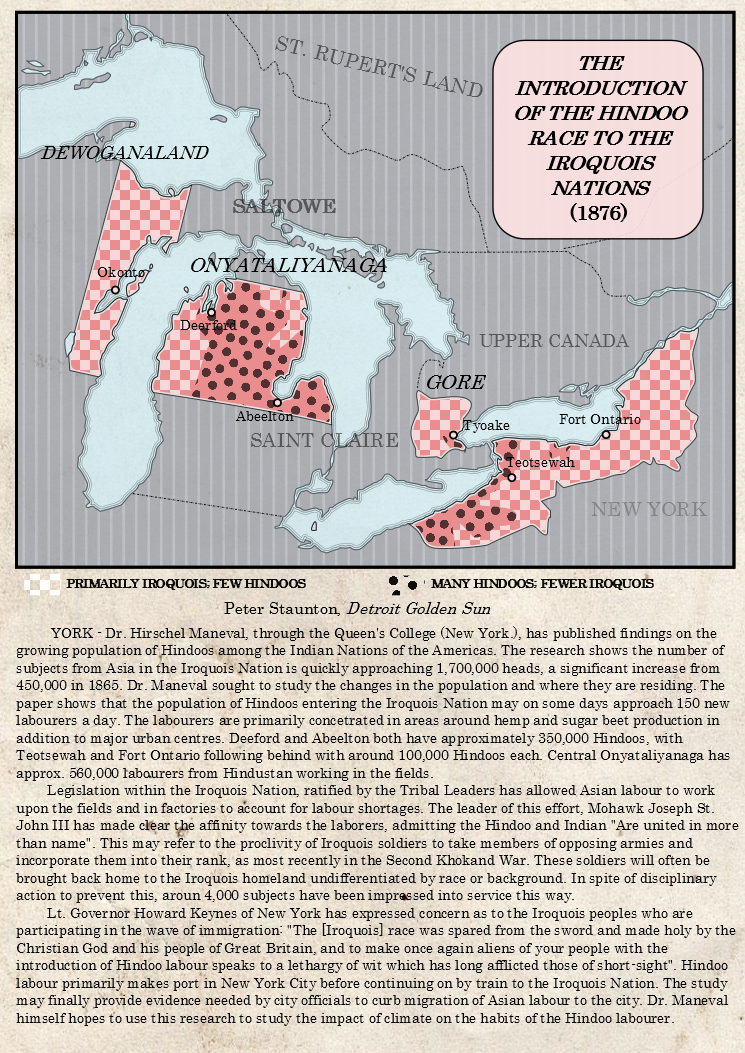Cross-Posting from MOTF

Hind(u) Migration to the Amerindian nations, 1833-1876
Hindustani Labor in the Iroquois Nation
Indentured servitude in Iroquois country began in the early 1830s with the introduction of commercial agriculture to the region. The formal acquisition of Onyatalianaga and Degowanaland was secured by the Proclamation of Teotsewah, when the Iroquois Nation formally pledged allegiance to the British Crown. The social order would take a different nature than the rest of the Iroquois Nation where land was held communally. The tribes still owned the land, but allotted the use to rentiers and smaller tribes to make revenue. The Iroquois Confederacy would add a Council of the West, where foreigners and non-Iroquois Indians would have minor input on major decisions going on in the Grand Council (see figure 6.4). Enterprising Iroquois and a select amount of English and non-English Europeans (who swore oaths to the nations of the Iroquois) began renting out land for commercial agriculture in Onyatalianaga.
Initially the labor was provided by prisoners contracted from Saint Claire penal colony, though Lord Waldegrave would revoke the contracts to further his own agricultural investments in Saint Claire. The Grand Council contracted several black companies in 1834, and negotiated the settlement of 3,000 laborers to the Okonto area. The Anglican and Quaker missionaries, who held significant political weight in the Council of the West were vehemently against the continued import of black freedmen and former slaves, and obstinately refused to allow more settlement. In their place, temporary laborers from Hindustan were suggested.
Hindustani labour first appeared in the Americas in 1799 as an experiment in replacing African slaves with indentured servants from India in Georgia, sponsored by the First Methodist Church of Philadelphia as an alternative practice to chattel slavery. The Slave trade would be abolished by 1808 from domestic unpopularity among the English populace and several particularly bad slave revolts in the colonies. In 1820, an abolitionist government in England inspired an insurrection among the slaveholding elite of North America, and militias mobilized from Demerara to Lake Chaplain. The Slaver War would rage for seven years across the continent, with soldiers from every British holding seeing combat in the Americas.
The Iroquois Nation would see significant fighting in the Homelands, with rebel general Anthony Rider destroying Fort Ontario, and reaching as far west as Ganandoguan. The British East India Company would be called upon to lend assistance to putting down slave revolts in the Caribbean, and would participate in the second Siege of Manhattan alongside the Iroquois and the Royal American Forces. Sepoy were utilized during the landings, and Hindustani troops would storm the Town Hall. It is here when the Joseph St. John III, the architect of the indentured labor system in the Iroquois Nation, first met Hindus and developed an affinity for the people.
St. John would become a chief after the Slaver War, and built a coalition out of westernized Iroquois (The Maple faction), Delaware, liberal missionaries, and business interests to push for Hindu labor in Onyatalianaga. By 1834, the primary opposition to the labor, the traditionalist faction of the Mohawk (The Pine faction), reached an agreement to allow foreign labor while extending hunting-foraging land in Degowanaland.
The contracts were handled by the Grand Council, and distributed to individuals and villages. Many Hindus were put to work on major infrastructure projects, such as paving the roads and laying out electrical infrastructure.The primary place where indentured servants were found were out in fields of hemp, sugar-beets, and potatoes. From the 1833 to 1858, the indentured servant population never exceeded 67,000.
Massive changes in the Iroquois Nation would soon increase demand for labor in the 1860s. The rise of the Red Maple movement and the 1862 Constitution would see the restriction of white settlement in the Iroquois Nation, while simultaneously opening up economic ventures previously restricted by the Grand Council, such as mining and banking. The modernizing projects of the Jacob Kite administration were primarily built by the indentured servants of Hindustan. When Kite left office in 1869, there were nearly half a million Hindus in the Iroquois Nations. The pro-business Amos Tall Pines allowed Emmett McClaskin and McClaskin Sugar Company to dominate the politics of Tyoake, who along with land-baron Wyatt Hood and timber magnate Louis Bell would pressure the Iroquois Nation to purchase nearly 600,000 servants for their agricultural businesses.
By 1875, McClaskin’s Planter party, have run into an opposition consisting of the remains of the traditionalists, the nationalist Iron Eagles House, and the Hindustani Worker’s Association of Onyatalianaga. A united opposition would certainly be able to usurp the Planters, but none of the three can get along with one another. HWAO and Eagles violently clashed in Deerford in early July of 1876, leading to a general strike in the city. This incident would provide the roots for the American Hindustan movement across the Western Hemisphere.



